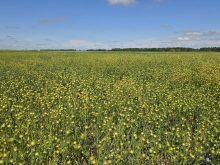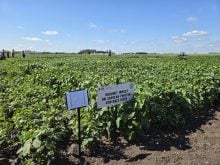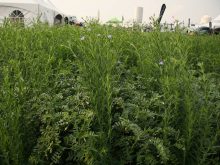A processor and exporter of Canadian flax remains confident about supplies despite plummeting acres in the United States.
“We were a bit nervous on being short acres and bushels to fill our contracts for our ingredient companies but that seems to be gone now,” said Evan Johnson, sales manager with TA Foods Ltd. in Yorkton, Sask.
“We’re very confident everything is going to go really well this year and we’re going to be busy as ever.”
Read Also

Huge Black Sea flax crop to provide stiff competition
Russia and Kazakhstan harvested huge flax crops and will be providing stiff competition in China and the EU.
The U.S. Department of Agriculture recently dropped its U.S. flax estimate to 235,000 acres, down from its March forecast of 360,000 acres.
Johnson doesn’t anticipate a similar drop in Canada where Statistics Canada is forecasting 866,970 acres of the crop. It was an enticing option for growers to plant with prices at three-times 2021 levels.
There may be some switching to shorter season crops in waterlogged areas where seeding was three to four weeks behind normal but that shouldn’t amount to a lot of land.
The flax that was planted is looking “very good,” he said.
Johnson has spoken to farmers who contracted 15 bushels per acre of flax with TA Foods who are anticipating 25 to 30 bushels per acre.
“We’re very optimistic and the growers that we’re contracting with sound the same,” he said.
MarketsFarm analyst Bruce Burnett doesn’t share that optimism.
He thinks acres will fall from the Statscan estimate because it is just as wet in the eastern Canadian Prairies as it is in North Dakota where farmers abandoned the crop.
However, there were better seeding conditions in some parts of Saskatchewan, so maybe the decline won’t be as dramatic as it was in the U.S.
Burnett thinks Canada’s flax crop is struggling with the wet conditions.
“We need some more heat and maybe a little more dryness in the east here to boost crop prospects,” he said.
“The wet areas have certainly not taken off in terms of crop development.”
Burnett believes farmers should brace for below-average yields, although there is still time for the crop to recover if conditions turn hot in July.
The Black Sea region is Canada’s big competitor in flax markets, particularly Kazakhstan.
Johnson is hearing that they will have plenty of crop to export but their prices have gone up and are now matching Canadian prices.
“It’s not ideal to be importing from those areas back into the U.S. or into Canada,” he said.
“Our exports into the U.S. market will remain strong again this year due to that.”
Kazakhstan exported 287,900 tonnes of flax between September 2022 and April 2023, down from 337,700 tonnes for the same period a year ago, according to APK Inform.
It reports that the area planted to oilseed crops in Kazakhstan, including flax, dropped by 152,399 acres this spring.
The National Project for the Development of Agro-Industrial Sector of Kazakhstan has set a target to more than double the export of the country’s vegetable oils by 2025.
That would require 8.9 million acres of oilseed planted area, up from 7.4 million acres today, the head of the plant processing department of Kazakhstan’s ministry of agriculture said during the country’s first Fats and Oils conference, according to APK Inform.
Kazakhstan’s flax production has already increased by 38 percent since 2016.
sean.pratt@producer.com


















